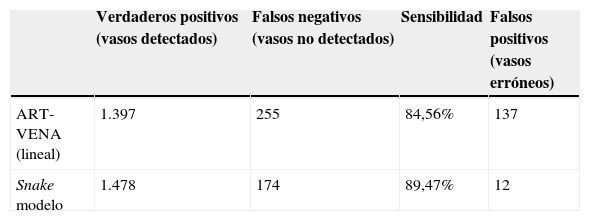Las guías europeas de hipertensión arterial consideran que es necesario un método que cuantifique de forma objetiva los cambios iniciales en la microcirculación retiniana del hipertenso. Previamente hemos descrito y validado un método semiautomático basado en un modelo lineal, con una alta sensibilidad y especificidad, pero con limitaciones.
Por este motivo, desarrollamos un método basado en el modelo de snakes, para medir el índice arteriovenoso retininano y lo hemos comparado con el método previamente descrito.
Pacientes y métodoPara validar este método, hemos analizado las fotografías digitales obtenidas de 173 ojos pertenecientes a un total de 96 pacientes hipertensos; la mayoría de éstos estaban recibiendo tratamiento. Las fotos se han realizado en 2 centros: A Coruña (66) y Santiago de Compostela (107), y la misma persona los ha analizado mediante ambos métodos en cada centro (lineal y snake).
ResultadosHemos observado que las medias y las diferencias de las determinaciones del índice arteriovenoso por ambos métodos son mínimas y siguen una distribución normal. El estadístico alfa de Cronbach fue de 0,974, con un coeficiente de correlación intraclase de 0,949 (p<0,001) para el grupo de imágenes de Santiago, mientras que para el grupo de A Coruña el estadístico alfa de Cronbach fue de 0,923, con un coeficiente de correlación intraclase de 0,857 (p<0,001).
ConclusiónSe trata de un método para el cálculo del índice arteriovenoso retiniano de una forma semiautomática, con una elevada sensibilidad y mayor especificidad que el previamente descrito y con una excelente correlación con el anterior.
Early alterations in retinal microcirculation are observed in most hypertensive patients seen in daily practice and the European guidelines consider it is necessary an objective method to quantify these alterations. We have previously described a semi-automatic computerized system to evaluate the calibre of retinal blood vessels that has shown high sensitivity and specificity to calculate the arteriovenous ratio (AVR), though with limitations. We describe a method based on the snakes model to calculate the arteriovenous ratio.
Patients and methodWe haved compared it with the previously reported lineal method, and we have analyed 173 digital photographs from 96 hypertensive patients, most of them reciveing treatment. Photos were made in two hospitals (A Coruña: 66 and Santiago de Compostela: 107), and were analysed by the same people in each Centre, by the lineal and snake method.
ResultsWe have observed that the arithmetic mean and the differences in AVR between both methods were minimal and showed a normal distribution. Cronbach statistics was 0.974 and intraclass correlation coefficient 0.949 (p<0.001), for the images from Santiago and 0.923 with an intraclass correlation coefficient of 0.857 (p<0.001) for the images from A Coruña.
ConclusionThis semiautomatic method to calculate the AVR ratio has a high sensitivity and a greater specificity than previous method, and the correlation between the results obtained with both is excellent.
Artículo
Comprando el artículo el PDF del mismo podrá ser descargado
Precio 19,34 €
Comprar ahora











